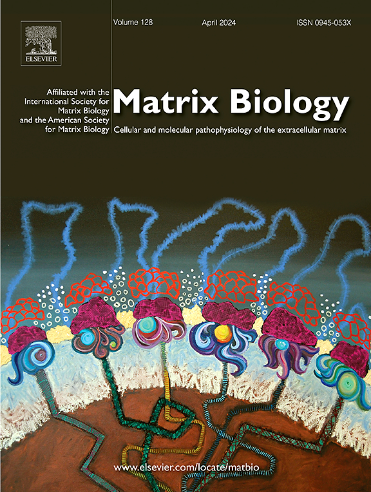Identification of CD44 as a key engager to hyaluronic acid-rich extracellular matrices for cell traction force generation and tumor invasion in 3D
IF 4.5
1区 生物学
Q1 BIOCHEMISTRY & MOLECULAR BIOLOGY
引用次数: 0
Abstract
Mechanical properties of the extracellular matrix (ECM) critically regulate a number of important cell functions including growth, differentiation and migration. Type I collagen and glycosaminoglycans (GAGs) are two primary components of ECMs that contribute to mammalian tissue mechanics, with the collagen fiber network sustaining tension, and GAGs withstanding compression. The architecture and stiffness of the collagen network are known to be important for cell-ECM mechanical interactions via cell surface adhesion receptor integrin. In contrast, studies of GAGs in modulating cell-ECM interactions are limited. Here, we present experimental studies on the roles of hyaluronic acid (HA) in single tumor cell traction force generation using a recently developed 3D cell traction force microscopy method. Our work reveals that CD44, a cell surface receptor to HA, is engaged in cell traction force generation in conjunction with β1-integrin. We find that HA significantly modifies the architecture and mechanics of the collagen fiber network, decreasing tumor cells’ propensity to remodel the collagen network, attenuating traction force generation, transmission distance, and tumor invasion. Our findings point to a novel role for CD44 in traction force generation, which can be a potential therapeutic target for diseases involving HA rich ECMs such as breast cancer and glioblastoma.
确定 CD44 是富含透明质酸的细胞外基质的关键参与因子,可产生细胞牵引力和三维肿瘤侵袭。
细胞外基质(ECM)的力学特性对许多重要的细胞功能(包括生长、分化和迁移)起着至关重要的调节作用。I 型胶原蛋白和糖胺聚糖(GAGs)是 ECM 的两种主要成分,它们对哺乳动物组织的力学性能起着重要作用。众所周知,胶原蛋白网络的结构和硬度通过整合素细胞表面粘附受体对细胞与 ECM 的机械相互作用非常重要。相比之下,对 GAGs 调节细胞-ECM 相互作用的研究却很有限。在此,我们采用最新开发的三维细胞牵引力显微镜方法,对透明质酸(HA)在单个肿瘤细胞牵引力产生中的作用进行了实验研究。我们的研究发现,细胞表面的 HA 受体 CD44 与 β1-integrin 共同参与了细胞牵引力的产生。我们发现 HA 能明显改变胶原纤维网络的结构和力学,降低肿瘤细胞重塑胶原网络的倾向,减少牵引力的产生、传输距离和肿瘤侵袭。我们的研究结果表明,CD44 在牵引力的产生过程中扮演着新的角色,可以成为乳腺癌和胶质母细胞瘤等涉及富含 HA 的 ECM 的疾病的潜在治疗靶点。
本文章由计算机程序翻译,如有差异,请以英文原文为准。
求助全文
约1分钟内获得全文
求助全文
来源期刊

Matrix Biology
生物-生化与分子生物学
CiteScore
11.40
自引率
4.30%
发文量
77
审稿时长
45 days
期刊介绍:
Matrix Biology (established in 1980 as Collagen and Related Research) is a cutting-edge journal that is devoted to publishing the latest results in matrix biology research. We welcome articles that reside at the nexus of understanding the cellular and molecular pathophysiology of the extracellular matrix. Matrix Biology focusses on solving elusive questions, opening new avenues of thought and discovery, and challenging longstanding biological paradigms.
 求助内容:
求助内容: 应助结果提醒方式:
应助结果提醒方式:


